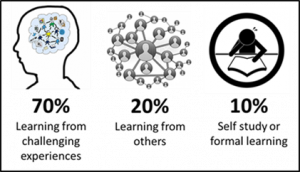
Through People


We often begin Leadership Development discussions by asking the question, “What occurred in your past that makes a difference in how you lead today?”. We’ve probably asked this 100 times and the results are always the same. Leaders report that they learned meaningful skills by navigating a variety of challenging experiences. Coupled with these developmental experiences were other people that provided developmental support, feedback, or mentoring, along with just-in-time study, training, or research.
The pattern of experience, people, and study that we heard matches the research conducted at the Center for Creative Leadership and subsequent global studies. This research identified that effective development has three key components that follow a 70-20-10 ratio: navigating challenging roles or assignments (70 percent), developmental support, coaching, mentoring, or role-modelling from others (20 percent) and self-study or training (10 percent).

The 70-20-10 Components of Effective Development
For development to be effective, it must be built into a leader’s day-to-day work and not be seen as something extra that has to be added to an already busy schedule. The only corollary to Build It In occurs when the present job is not challenging enough. In this case, the leader’s role needs to change, the job revised or more challenging assignments added.
Research has found that how challenging an experience is predicts how much learning will occur as a result of the experience. Without significant challenge, referred to as “Developmental Heat” our brains remain on autopilot and employ behaviors stored in long-term memory.
As the neuroscience research has highlighted, human brains are pattern recognition machines that like certainty. Only when patterns are perceived as significantly different do our brains snap out of standard operating procedure and kick in its energy-intensive, short-term memory prefrontal cortex. Focused energy and attention creates new neural connections that are imbedded in long-term memory. These new connections/habits/behaviors can then be easily recalled when needed – sometimes unconsciously.
Most key leadership roles challenges typically involve plenty of potentially brain-changing opportunities. Assuring that learners focus their energy and attention during those learning opportunities is a hallmark of our approach to development – Intentional Leadership Development.